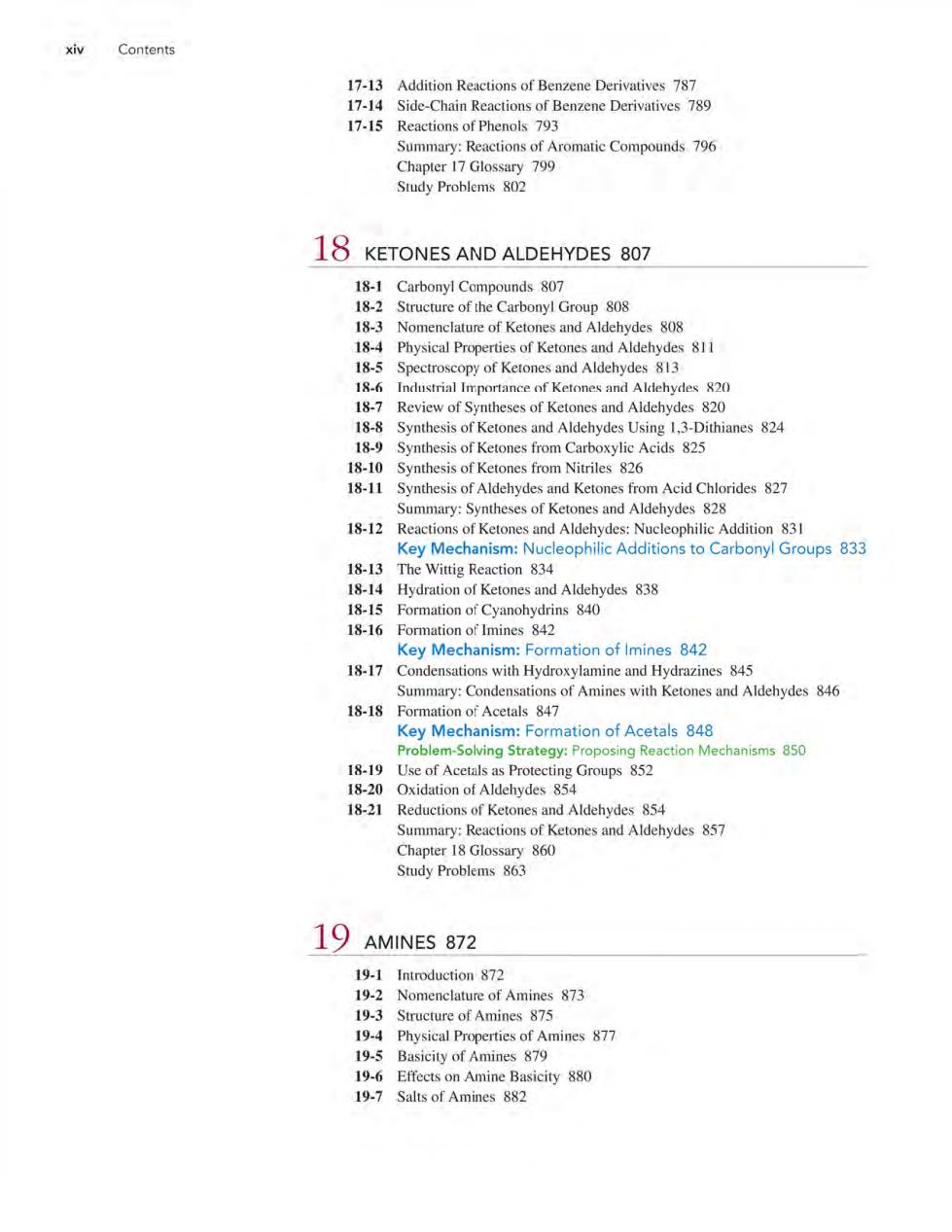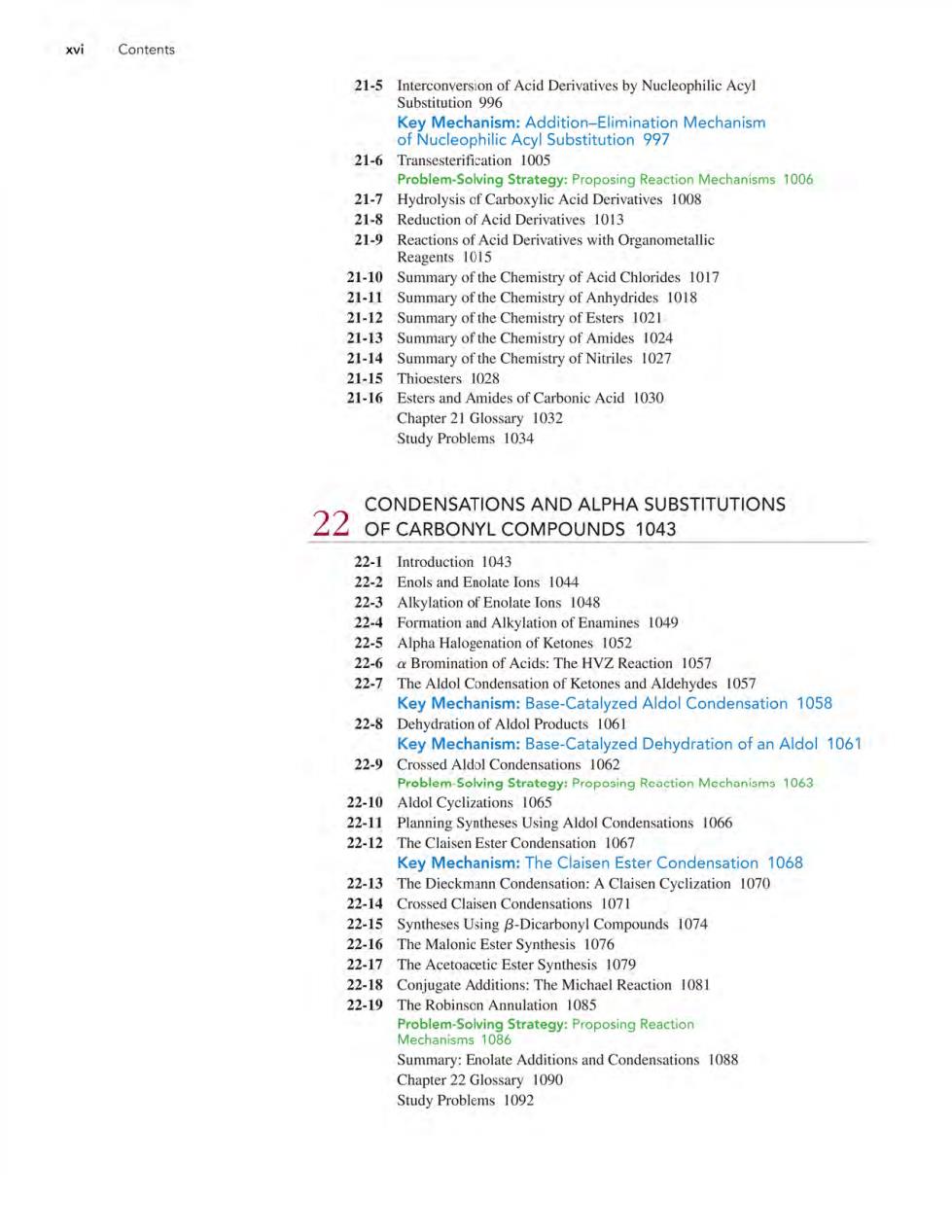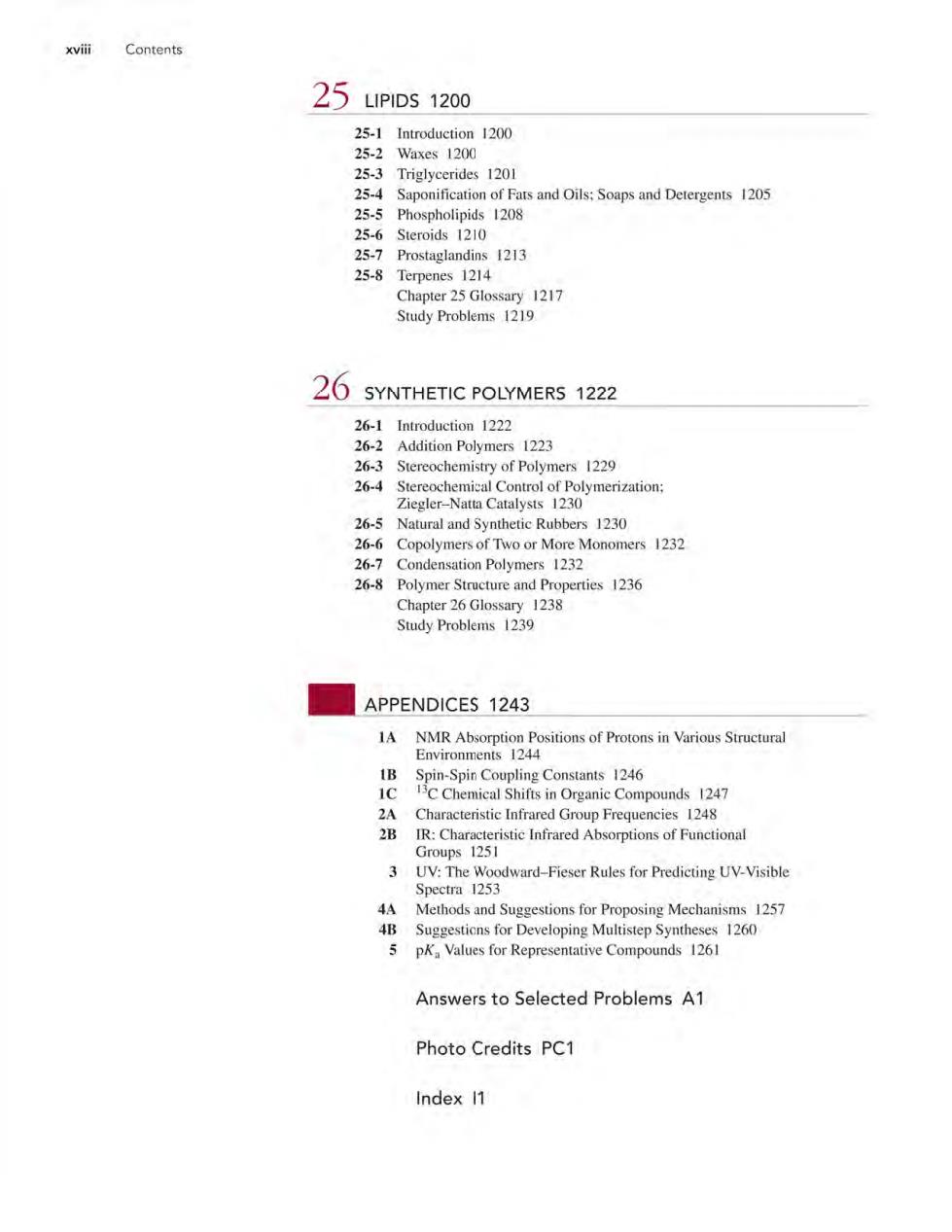
xiv Contents 17-13 Addition Reactions of Benzene Derivatives 787 17-14 Side-Chain Reactions of Benzene Derivatives 789 17-15 Reactions of Phenols 793 Summary:Reactions of Aromatic Compounds 796 Chapter 17 Glossary 799 Study Problems 802 18 KETONES AND ALDEHYDES 807 18-1 Carbonyl Compounds 807 18-2 Structure of the Carbonyl Group 808 18-3 Nomenclature of Ketones and Aldehydes 808 18-4 Physical Properties of Ketones and Aldehydes 811 185 Spectroscopy of Ketones and Aldehydes 813 18-6 Industrial Importance of Ketones and Aldehydes 820 18-7 Review of Syntheses of Ketones and Aldehydes 820 8- Synthesis of Ketones Alde from N 1保12 nd Ald d Addition 831 oups 833 18-13 The Wintig Beaction 834 18-14 Hvdration of Ketones and Aldehydes 838 18.15 Formation of Cvanohydrins 840 18-16 Formation of Imines 842 Key Mechanism:Formation of Imines 842 18-17 Condensations with Hydroxylamine and Hydrazines 845 Summary:Condensations of Amines with Ketones and Aldehydes 846 18-18 Formation of Acetals 847 18.10 Use of Ac eaction Mechanisms 850 18-20 18-21 Reductions of Keto nes and Aldehydes 854 Summary:Reactions of Ketones and Aldehydes 857 Chapter 18 Glossary 860 Study Problems 863 19 AMINES 872 19-1 Introduction 872 19-2 Nomenclature of Amines 873 19-3 Structure of Amines 875 19-4 Physical Properties of Amines 877 19-5 Basicity of Amines 879 199 Effects on Amine Basicity 880 Salts of Amines 882
xiv Contents 17-13 Addition Reactions of Benzene Derivatives 787 17-14 Side-Chain Reactions of Benzene Derivatives 789 17-15 Reactions of Phenols 793 Summary: Reactions of Aromatic Compounds 796 Chapter 17 Glossary 799 Study Problems 802 18 KETONES AND ALDEHYDES 807 18-1 Carbonyl Compounds 807 18-2 Structure of the Carbonyl Group 808 18-3 Nomenclature of Ketones and Aldehydes 808 18-4 Physical Properties of Ketones and Aldehydes 811 18-5 Spectroscopy of Ketones and Aldehydes 813 18-6 Industrial Importance of Ketones and Aldehydes 820 18-7 Review of Syntheses of Ketones and Aldehydes 820 18-8 Synthesis of Ketones and Aldehydes Using 1,3-Dithianes 824 18-9 Synthesis of Ketones from Carboxylic Acids 825 18-10 Synthesis of Ketones from Nitriles 826 18-11 Synthesis of Aldehydes and Ketones from Acid Chlorides 827 Summary: Syntheses of Ketones and Aldehydes 828 18-12 Reactions of Ketones and Aldehydes: Nucleophilic Addition 831 Key Mechanism: Nucleophilic Additions to Carbonyl Groups 833 18-13 The Wittig Reaction 834 18-14 Hydration of Ketones and Aldehydes 838 18-15 Formation of Cyanohydrins 840 18-16 Formation oflmines 842 Key Mechanism: Formation of lmines 842 18-17 Condensations with Hydroxylamine and Hydrazines 845 Summary: Condensations of Arnines with Ketones and Aldehydes 846 18-18 Formation of Acetals 84 7 Key Mechanism: Formation of Acetals 848 Problem-Solving Strategy: Proposing Reaction Mechanisms 850 18-19 Use of Acetals as Protecting Groups 852 18-20 Oxidation of Aldehydes 854 18-21 Reductions of Ketones and Aldehydes 854 Summary: Reactions of Ketones and Aldehydes 857 Chapter 18 Glossary 860 Study Problems 863 19 AMINES 872 19-1 Introduction 872 19-2 Nomenclature of Amines 873 19-3 Structure of Amines 875 19-4 Physical Properties of Amines 877 19-5 Basicity of Amines 879 19-6 Effects on Amine Basicity 880 19-7 Salts of Amines 882

Contents XV 19-8 Amine Salts as Phase-Transfer Catalysts 884 19-9 Sn 19-10 Reactions of Amines with Ketones and Aldehydes (Review)890 19.11 Aromatic Substitution of Arylamines and Pyridine 890 19.12 Alkylation of Amines by alkyl Halides 894 19.13 Acylation of Amines by Acid Chlorides 895 19-14 Formation of Sulfonamides 897 19-15 Amines as Leaving Groups:The Hofmann Elimination 898 19-16 Oxidation of Amines:The Cope Elimination 902 1917 Reactions of Amines with Nitrous Acid 904 19-18 906 by 19-21 Acylati 916 Of A 923 Chapter 19 Glossary 925 Study Problems 928 20 CARBOXYLIC ACIDS 937 20-1 Introduction 937 20-2 Nomenclature of Carboxvlic Acids 937 203 Cab Salts of Car oxylie Acids 946 Spectroscopy of Carb Synthe mmary:S c Acids 957 20.9 20-10 Condensation of Acids with Alcohols:The Fischer Esterification 960 Key Mechanism:Fischer Esterification 961 20-11 Esterification Using Diazomethane 964 20-12 Condensation of Acids with Amin 96 nd Us of Acid Ch Acids970 972 s973 21 CARBOXYLIC ACID DERIVATIVES 980 21-1 Introduction 980 21-2 Structure and Nomenclature of Acid Derivatives 981 21-3 Physical Properties of Carboxylic Acid Derivatives 987 21-4 Spectroscopy of Carboxylic Acid Derivatives 989
19-8 Amine Salts as Phase-Transfer Catalysts 884 19-9 Spectroscopy of Amines 886 19-10 Reactions of Amines with Ketones and Aldehydes (Review) 890 19-11 Aromatic Substitution of Arylamines and Pyridine 890 19-12 Alkylation of Amines by Alkyl Halides 894 19-13 Acylation of Amines by Acid Chlorides 895 19-14 Formation of Sulfonamides 897 19-15 Amines as Leaving Groups: The Hofmann Elimination 898 19-16 Oxidation of Amines; The Cope Elimination 902 19-17 Reactions of Amines with Nitrous Acid 904 19-18 Reactions of Arenediazonium Salts 906 Summary: Reactions of Amines 910 19-19 Synthesis of Amines by Reductive Amination 912 19-20 Synthesis of Amines by Acylation-Reduction 915 19-21 Syntheses Limited to Primary Amines 916 Summary: Synthesis of Amines 923 Chapter 19 Glossary 925 Study Problems 928 20 CARBOXYLIC ACIDS 937 20-1 Introduction 937 20-2 Nomenclature of Carboxylic Acids 937 20-3 Structure and Physical Properties of Carboxylic Acids 941 20-4 Acidity of Carboxylic Acids 942 20-5 Salts of Carboxylic Acids 946 20-6 Commercial Sources of Carboxylic Acids 949 20-7 Spectroscopy of Carboxylic Acids 950 20-8 Synthesis of Carboxylic Acids 954 Summary: Syntheses of Carboxylic Acids 957 20-9 Reactions of Carboxylic Acids and Derivatives; Nucleophilic Acyl Substitution 958 20-10 Condensation of Acids with Alcohols: The Fischer Esterification 960 Key Mechanism: Fischer Esterification 961 20-11 Esterification Using Diazomethane 964 20-12 Condensation of Acids with Amines: Direct Synthesis of Amides 965 20-13 Reduction of Carboxylic Acids 965 20-14 Alkylation of Carboxylic Acids to Form Ketones 967 20-15 Synthesis and Use of Acid Chlorides 968 Summary: Reactions of Carboxylic Acids 970 Chapter 20 Glossary 972 Study Problems 973 21 CARBOXYLIC ACID DERIVATIVES 980 21-1 Introduction 980 21-2 Structure and Nomenclature of Acid Derivatives 981 21-3 Physical Properties of Carboxylic Acid Derivatives 987 21-4 Spectroscopy of Carboxylic Acid Derivatives 989 Contents xv

xvi Contents 21-5 Interconversion of Acid Derivatives by Nucleophilic Acyl n996 Mechanism 21-6 Transesterification 1005 Problem-Solving Strategy:Proposing Reaction Mechanisms 1006 21-7 Hydrolysis of Carboxylic Acid Derivatives 1008 21-8 Reduction of Acid Derivatives 1013 21-9 Reactions of Ac Derivativeswith Organometallic 3110 Sumn 31.11 21.12 Summary of the Che 21.13 Summary ofthe chemistry of Amides 1024 21-14 Summary of the Chemistry of Nitriles 1027 21.15 Thioesters 1028 21-16 Esters and Amides of Car bonic Acid 1030 Chapter 21 Glossary 1032 Study Problems 1034 CONDENSATIONS AND ALPHA SUBSTITUTIONS 22 OF CARBONYL COMPOUNDS 1043 22.3 Ion 104g 22.4 mines 1049 33.5 Alpha Halog es1052 126 a Bromination of Acids:The HVZ Reaction 1057 22-7 The Aldol Condensation of Ketones and Aldehydes 1057 Key Mechanism:Base-Catalyzed Aldol Condensation 1058 22-8 Dehydration of Aldol Products 1061 Key Mechanism:Base-Catalyzed Dehydration of an Aldol 1061 22-9 Cros sed Aldol Condensations 1062 ng S ons 2212 ng Sy sing Aldol Condensations106 Co 1067 Key Mechanism:The Cla Ester Condensation 1068 The Dieckm ann cond Crossed Claisen Condensations 1071 22.15 Syntheses Using B-Dicarbonyl Compounds 1074 22.16 The Malonic Ester Synthesis 1076 22.17 The Acetoacetic Ester Synthesis 1079 22-18 Conjugate Additions:The Michael Reaction 1081 22.19 The Robinson Annulation 1085 robm-Soving Strategy:Proposing Reaction Summary:Enolate Additions and Condensations 1088 Chapter 22 Glossary 1090 Study Problems 1092
xvi Contents 21-5 Interconversion of Acid Derivatives by Nucleophilic Acyl Substitution 996 Key Mechanism: Addition-Elimination Mechanism of Nucleophilic Acyl Substitution 997 21-6 Transesterification 1005 Problem-Solving Strategy: Proposing Reaction Mechanisms 1006 21-7 Hydrolysis of Carboxylic Acid Derivatives I 008 21-8 Reduction of Acid Derivatives 1013 21-9 Reactions of Acid Derivatives with Organometallic Reagents 1015 21-10 Summary of the Chemistry of Acid Chlorides 1017 21-11 Summary of the Chemistry of Anhydrides 1018 21-12 Summary of the Chemistry of Esters 1021 21-13 Summary of the Chemistry of Amides 1024 21-14 Summary of the Chemistry of Nitriles 1027 21-15 Thioesters 1028 21-16 Esters and Amides of Carbonic Acid 1030 Chapter 21 Glossary 1032 Study Problems 1034 CONDENSATIONS AND ALPHA SUBSTITUTIONS 22 OF CARBONYL COMPOUNDS 1043 22-1 Introduction 1043 22-2 Enols and Enolate Ions 1044 22-3 Alkylation of Enol ate Ions 1048 22-4 Formation and Alkylation of Enamines 1049 22-5 Alpha Halogenation of Ketones 1052 22-6 a Bromination of Acids: The HVZ Reaction 1057 22-7 The Aldol Condensation of Ketones and Aldehydes 1057 Key Mechanism: Base-Catalyzed Aldol Condensation 1 058 22-8 Dehydration of Aldol Products 1061 Key Mechanism: Base-Catalyzed Dehydration of an Aldol 1 061 22-9 Crossed Aldol Condensations 1062 Problem-Solving Strategy: Proposing Reaction Mechanisms 1063 22-10 Aldol Cyclizations 1065 22-11 Planning Syntheses Using Aldol Condensations 1066 22-12 The Claisen Ester Condensation 1067 Key Mechanism: The Claisen Ester Condensation 1068 22-13 The Dieckmann Condensation: A Claisen Cyclization 1070 22-14 Crossed Claisen Condensations 1071 22-15 Syntheses Using {3-Dicarbonyl Compounds 1074 22-16 The Malonic Ester Synthesis 1076 22-17 The Acetoacetic Ester Synthesis 1079 22-18 Conjugate Additions: The Michael Reaction 1081 22-19 The Robinson Annulation 1085 Problem-Solving Strategy: Proposing Reaction Mechanisms 1086 Summary: Enolate Additions and Condensations 1088 Chapter 22 Glossary 1090 Study Problems 1092

Contents 23 CARBOHYDRATES AND NUCLEIC ACIDS 1097 23-1 Introduction 1097 23- Classification of Carbohydrates 1098 Monosaccharides 109 Epime 23. s:Side Re Base 1110 ides 112 23-10 Oxidation of mo 23-11 Nonreducing Sugars:Formation of Glyce 23-12 Ether and Ester Formation I117 23-13 Reactions with Phenylhydrazine:Osazone Formation 1119 23-14 Chain Shortening:The Rutf Degradation I120 23-15 Chain Lengthening:The Kiliani-Fischer Synthesis 1121 Summary:Reactions of Sugars 1122 23-16 Fischer's Proof of the Configuration of Glucose 1124 Determination of Ring Size:Periodic Acid Cleavage of Sugars 1127 Acids. ction 1137 e tides 1139 leic Acid 1141 23.23 and the Structur ckeic Acid 1141 23-24 Chapter 23 Glossary 1147 Study Problems 1140 24 AMINO ACIDS,PEPTIDES,AND PROTEINS 1153 24-1 Introduction 1153 d Su eochemisrry of the amino acids I54 24-3 Acid-Base Pronerties of Amino Acids 1158 24-4 Isoelectric Points and Electrophoresis 1160 24-5 Synthesis of Amino Acids 1161 Summary:Syntheses of Amino Acids 1166 Resolution of Amino Acids 116 24-7 Reactions of Amino Acids 1167 Summary:Reactions of Amino Acids 1170 248 Peptidesand Peptide Structure D Solid- de Synth 1188 2413 vels of otein 18 24-14 Protein Denaturation 1191 Chapter 24 Glossary 119 Study Problems 1196
23 CARBOHYDRATES AND NUCLEIC ACIDS 1097 23-1 Introduction 1097 23-2 Classification of Carbohydrates 1098 23-3 Monosaccharides 1099 23-4 Erythro and Threo Diastereomers 1102 23-5 Epimers 1103 23-6 Cyclic Structures of Monosaccharides 1104 23-7 Anomers of Monosaccharides; Mutarotation 1108 23-8 Reactions of Monosaccharides: Side Reactions in Base 1110 23-9 Reduction of Monosaccharides 1112 23-10 Oxidation of Monosaccharides; Reducing Sugars 1113 23-11 Nonreducing Sugars: Formation of Glycosides 1115 23-12 Ether and Ester Formation 1117 23-13 Reactions with Phenylhydrazine: Osazone Formation 1119 23-14 Chain Shortening: The Ruff Degradation 1120 23-15 Chain Lengthening: The Kiliani-Fischer Synthesis 1121 Summary: Reactions of Sugars 1122 23-16 Fischer's Proof of the Configuration of Glucose 1124 23-17 Determination of Ring Size; Periodic Acid Cleavage of Sugars 1127 23-18 Disaccharides 1129 23-19 Polysaccharides 1134 23-20 Nucleic Acids: Introduction 1137 23-21 Ribonucleosides and Ribonucleotides 1139 23-22 The Structure of Ribonucleic Acid 1141 23-23 Deoxyribose and the Structure of Deoxyribonucleic Acid 1141 23-24 Additional Functions of Nucleotides 1145 Chapter 23 Glossary 1147 Study Problems 1149 24 AMINO ACIDS, PEPTIDES, AND PROTEINS 1153 24-1 Introduction 1153 24-2 Structure and Stereochemistry of the a-Amino Acids 1154 24-3 Acid-Base Properties of Amino Acids 1158 24-4 Isoelectric Points and Electrophoresis 1160 24-5 Synthesis of Amino Acids 1161 Summary: Syntheses of Amino Acids 1166 24-6 Resolution of Amino Acids 1167 24-7 Reactions of Amino Acids 1167 Summary: Reactions of Amino Acids 1170 24-8 Structure and Nomenclature of Peptides and Proteins 1170 24-9 Peptide Structure Determination 1174 24-10 Solution-Phase Peptide Synthesis 1180 24-11 Solid-Phase Peptide Synthesis 1183 24-12 Classification of Proteins 1188 24-13 Levels of Protein Structure 1188 24-14 Protein Denaturation 1191 Chapter 24 Glossary 1193 Study Problems 1196 Contents xvii

Contents 25LP1D51200 201200 ides 120 25-5 paponi holipids 1208 f Fats and Oils:Soaps and Detergents 1205 25-6 Sterpids 1210 25-7 Prostaglandios 1213 25-8 Terpenes 1214 Chapter 25 Glossary 1217 Study Problems 1219 26 SYNTHETIC POLYMERS 1222 1223 hers 1229 26-4 Ziegler-Natt Catalysts 1230 26-5 Natural and Synthetic Rubbers 1230 26-6 Copolymers of Two or More Monomers 1232 26-7 Condensation Polymers 1232 26-8 Polymer Structure and Properies 1236 APPENDICES 1243 1A Spin-Spin Coupling Constants 1246 C Chemical Shifts in Organie Compounds 1247 Characteristic Infrared Group Frequencie 124 3 UV:The Woodward-Fieser Rules for Predicting UV-Visible Spectra 1253 Methods and Suggestions for Proposing Mechanisms 1257 Suggesticns for Developing Multistep Syntheses 1260 5 pK Values for Representative Compounds 126 Answers to Selected Problems A1 Photo Credits PC1 Index 11
xviii Contents 25 LIPIDS 1200 25-1 Introduction 1200 25-2 VVaxes 1200 25-3 Triglycerides 1201 25-4 Saponification of Fats and Oils; Soaps and Detergents 1205 25-5 Phospholipids 1208 25-6 Steroids 1210 25-7 Prostaglandins 1213 25-8 Terpenes 1214 Chapter 25 Glossary 1217 Study Problems 1219 26 SYNTHETIC POLYMERS 1222 26-1 Introduction 1222 26-2 Addition Polymers 1223 26-3 Stereochemistry of Polymers 1229 26-4 Stereochemical Control of Polymerization; Ziegler-Natta Catalysts 1230 26-5 Natural and Synthetic Rubbers 1230 26-6 Copolymers of Two or More Monomers 1232 26-7 Condensation Polymers 1232 26-8 Polymer Structure and Properties 1236 Chapter 26 Glossary 1238 Study Problems 1239 APPENDICES 1243 1A NMR Absorption Positions of Protons in Various Structural Environments 1244 1B Spin-Spin Coupling Constants 1246 1C 13C Chemical Shifts in Organic Compounds 1247 2A Characteristic Infrared Group Frequencies 1248 2B IR: Characteristic Infrared Absorptions of Functional Groups 1251 3 UV: The VVoodward-Fieser Rules for Predicting UV-Visible Spectra 1253 4A Methods and Suggestions for Proposing Mechanisms 1257 4B Suggestions for Developing Multistep Syntheses 1260 5 pKa Values for Representative Compounds 1261 Answers to Selected Problems A 1 Photo Credits PC1 Index 11